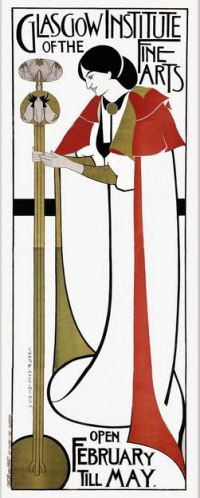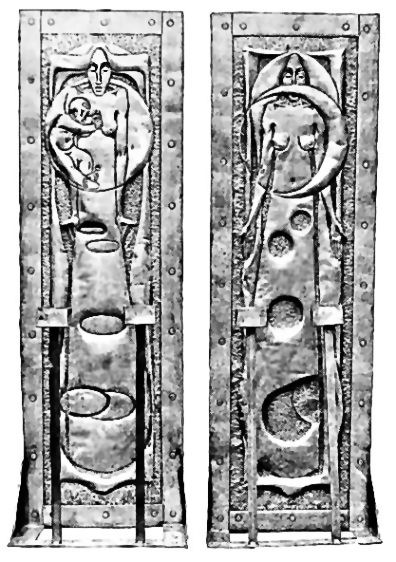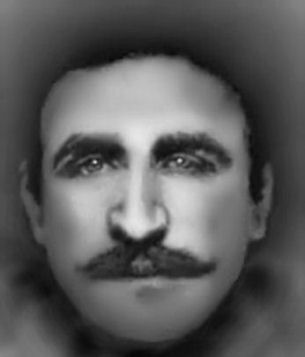
This page is dedicated to the unique design skills of Charles Rennie Mackintosh, which he developed as an added dimension to his architectural work in Glasgow. His career as an architect continued in parallel with his role as a pioneer of the Art Noveau movement in continental Europe.
In January 1895, Alphonse Mucha, an early proponent of Art Nouveau in Paris, published a
lithographed poster featuring Sarah Bernhardt
which started a fashion for the public display of mass-produced stylised ladies.
Mackintosh designed poster for annual exhibition of the Glasgow Institute of the Fine Arts, 1895
Charles Rennie Mackintosh's signature on above poster
Charles Rennie Mackintosh's experimentation with images of stylised ladies was influenced by the work of the eccentric English innovator of Art Nouveau drawing styles, Aubrey Beardsley, whose portrait of Madame Réjane, a theatrical rival of Sarah Bernhardt, was on display at the annual exhibition of the Glasgow Institute of the Fine Arts in 1895.
Mackintosh's perspective drawing of Queen Margaret College was also shown at the exhibition which features in my Rennie Mackintosh - Architect page. The Arts Critic of the Glasgow Herald was not overly impressed with Mackintosh's drawing but was very complimentary about the exhibit of Aubrey Beardsley, which he thought was "executed in refined and dainty pen-work".
One of Mackintosh's strangest depictions of a stylised lady could possibly have been inspired by the erotic art of Aubrey Beardsley. 'Design for a poster for a magazine of Art, Literature and Science' by Charles Rennie Mackintosh
The face used in the above image was used in the published poster below, with the eyebrows inverted to give a more benign expression. The symbols on the breasts have been replaced with joyful little songbirds.
In Europe Mackintosh was more famous for his decorative art than for his architecture. He was an honourary member of the Vienna Secession and was highly regarded as a designer of furniture and interior decoration. German-language publications from around 1900 featured examples of Mackintosh design, such as the wall covering and wardrobe shown below.
In 1900 Josef Hoffmann, vice-president of the Vienna Secession, visited Britain where he met Charles Rennie Mackintosh and was greatly impressed with his designs which were to have a strong influence on the exponents of Art Nouveau, or 'Jugendstil' as it was known in German. The Mackintosh Room at the 8th exhibition of the Vienna Secession, published in Dekorative Kunst, 1901
Contrasting versions of Mackintosh's stencilled roses published in Ver Sacrum, the journal of the Vienna Secession, 1901
Earlier in 1900, prior to his Vienna display, Mackintosh's sketches for an 'Artist's Cottage and Studio' had been shown at the annual exhibition of the Royal Glasgow Institute of the Fine Arts. The negative comments in the Glasgow Herald are in stark contrast to the appreciation received in German-language journals for his Exhibition Room in Vienna.
Mackintosh's individualistic design style and contribution to the development of Jugendstil seem to have been beyond the comprehension of local reviewers.
Extract from the Glasgow Herald review of the Royal Glasgow Institute of the Fine Arts, 26th April 1900
South Elevation of 'Artist's Cottage and Studio', Charles Rennie Mackintosh, 1900
West Elevation of 'Artist's Cottage and Studio', Charles Rennie Mackintosh, 1900
3D model of Mackintosh's 'Artist's Cottage and Studio'
A building derived from Mackintosh's designs was completed in Farr, Inverness-shire, in 1992. The architect behind the project was Robert Hamilton Macintyre.
In Glasgow's south side you can visit the House for an Art Lover, or 'Haus eines Kunstfreundes', which Charles Rennie Mackintosh designed in 1901 for a competition entry in the German-language magazine Zeitschrift für Innendekoration. It was never built in his lifetime but his vision was realised in the closing years of the century when the house was constructed within Bellahouston Park, opening to the public in 1996.
Mackintosh's elevation for 'Haus eines Kunstfreundes', House for an Art Lover
Cover of Mackintosh's portfolio of competition drawings for House for an Art Lover
Mackintosh's perspective drawing for House for an Art Lover
A selection of drawings from Mackintosh's portfolio can be viewed alongside photographs of the same features at the House for an Art Lover page of this website.
In 1902 Mackintosh was invited to design the layout of the Scottish Section of the International Exhibition of Modern Decorative Art in Turin, Italy. One of the allocated spaces was used by Charles and Margaret for their 'Salonttino Delle Rose' or Rose Boudoir. Exhibits were also created by Herbert and Frances McNair and other exponents of the 'Glasgow Style'. The 'Esposizione Internazionale d'Arte Decorativa Moderna', which was open to the public from May to November 1902, was exclusively dedicated to modern design ideas. It was stipulated that “neither mere imitations of past styles nor industrial products not inspired by an artistic sense will be accepted”.
'Salonttino Delle Rose', the Rose Boudoir designed by Charles Rennie Mackintosh & Margaret Macdonald, Turin, 1902
The decorated aisle leading from the Scottish Section of the exhibition, (below left) featured the Mackintoshes familiar elongated ladies. The furnishings (below right) were put to other uses on their return to Glasgow.
Stencilled panels used to decorate entrance to the Rose Boudoir, Turin, 1902
Mackintosh's designs for decorative roses were faithfully reproduced in the upholstery of the chairs featured in the Rose Boudoir
The high backed white chair displayed at Turin was part of a set designed for the Willow Tea Rooms, Sauchiehall Street
The motif below was used to decorate the doors of a cabinet designed by Mackintosh for a Mrs Rowat in 1902.
Mrs Rowat's cabinet on display at the Mackintosh House, Hunterian Museum, Glasgow
Portait of Margaret Macdonald Mackintosh beside an example of her decorative metalwork
Close up view of decorative metalwork featured in Margaret Macdonald Mackintosh's portrait
This example of Macdonald sisters' work featured stylised naked ladies, minus the obligatoty roses on their breasts, in a pair of beaten brass sconces which were used for holding light fittings.
Brass sconces by Margaret and Frances Macdonald
Mackintosh enjoyed freedom of expression for the interior slyling of the Hill House in Helensburgh which was built for the publisher, Walter Blackie. His designs were radically futuristic, created without the restrictions which could have been imposed by a more conservative client.
The interior of the Hill House featured repetitive square motifs on walls, carpets, chairs, and furniture, with rose stencils used for wall decoration.
One of the most spectacular uses of Mackintosh roses, both stencilled and embroidered, was created at Windyhill, Kilmacolm. His fireplace with typical square motifs is surrounded by decorative seating and stencilled wall decoration typical of his style in 1905 when the photograph was published.
Fireplace at Windyhill surrounded by stencilled and embroidered Mackintosh roses
A decade after his architectural career in Glasgow had finished, Mackintosh retained his fascination for roses and repetitive squares. Perhaps the strangest representation of this comes from from a drawing produced during his time in Suffolk around 1914 / 1915. The artwork features roses erupting from a three dimensional lattice and little squares falling ahead of the rose-coloured teardrops.
In contrast to Mackintosh's twentieth century interiors with their geometric crispness and restrained use of colour, his formative work was much different. Mackintosh's earliest exhibited interior design, from 1896, used strong shades of green, blue and purple to emphasise his decorative scheme.
His 'Design for a library in a Glasgow house' was displayed at the annual exhibition of the Glasgow Institute of the Fine Arts in 1896. The stinging criticism in the Glasgow Herald of 7th March 1896 may have been responsible for his altered preferences in the choice of colours for his subsequent work.
The combination of purples and greens seen by the critic as a "sign of decadence" is shown below.
It would appear that after this public criticism Mackintosh held back from further ventures into a style of decorative art inspired by the ‘Celtic Renascence’ of Professor Patrick Geddes. The ‘Celtic Renascence’ was a cultural movement more locally focussed than either Arts and Crafts or Art Nouveau. The newspaper critic was aware of the dangers that Mackintosh’s exhibit could pose to this new artistic movement if it were to be "blighted by a cold blast of this kind of thing". Mackintosh was seen as a leading proponent of a style which an unidentified "band of young Glasgow artists seem determined to introduce everywhere". This could perhaps be an oblique reference to the ‘Glasgow Boys’, who experienced hostility to having their daring artworks displayed in the city's galleries and institutions.
Left side of Rennie Mackintosh's 'Design for a library in a Glasgow house'
Right side of Rennie Mackintosh's 'Design for a library in a Glasgow house'
Like Aubrey Beardsley's 'Portrait of Madame Réjane', Charles Rennie Mackintosh's 'Design for a library in a Glasgow house' is now in the possession of the Metropolitan Museum of Art, New York City.
The artwork used for Mackintosh's posters around the time of the 1896 exhibition show the vilified greens and purples rather than his now familiar black and white motifs, compared and contrasted in the examples below.
Examples of poster art by Charles Rennie Mackintosh
Mackintosh's earliest posters from around 1894 appear to anticipate the future themes and scripts of Art Nouveau at a time when the movement was in its formative period. This was before he had fully developed his own distinctive style.
Mackintosh designed poster for Glasgow Architectural Association, 1894
Mackintosh designed 'Diploma of Honour' certificate for the Glasgow School of Art Club, 1894
Around the same time Mackintosh created his very own fantasy female for the poster for the
annual exhibition of the Glasgow Institute of the Fine Arts of 1895, creating something
radically different for design style in his home town.


The design below features a figure held in a pillory with openings for her head, arms and exaggerated breasts, which were emblazoned with Mackintosh motifs. The upper body was placed over legs appearing like the elongated tentacles of a marine creature. I wouldn't want to speculate on the meaning of the lump between the figure's legs!
Not surprisingly, the proposed design does not seem to have been considered for use in any English language publication.


Mackintosh and 'Glasgow Boy', John Lavery, were included in the list of members of the Vienna Secession from 1902, shown below.



The 'Glasgow Four', Charles Rennie Mackintosh, his wife Margaret Macdonald, and Herbert and Frances McNair, were invited to contribute to the 8th exhibition of the Vienna Secession in the autumn of 1900, where they created a furnished room to display their work.






















The photographs below show the the master bedroom and the entrance hall of the Hill House. They were published in German-language journal, Dekorative Kunst
in 1905, shortly after the completion of the house.



Mackintosh's preference for numerous squares and geometric patterns inspired his fellow artist-architect and member of the Vienna Secession, Josef Hoffmann, who was
designing houses, furniture and silverware at the same time. In 1903 Hoffmann formed the 'Wiener Werkstätte', a workshop for creative artists and craftsmen.
Both Mackintosh and Hoffmann were moving away from the flowing curved ladies and the styles and patterns of earlier Art Nouveau in the manner of Aubrey Beardsley, Alphonse Mucha and Gustav Klimt. There was a change of emphasis towards simpler forms which can be seen in the two men's later work.











